One radiator in the apartment does not heat. What to do if the radiators in the apartment do not heat
Can't figure out why the radiator isn't heating up? Dont be upset. We will help your grief. Just read this article and follow our instructions. We are confident that after this your battery will work as it should.
Radiators do not heat up
Why the batteries in the apartment do not heat up - diagnosis and localization of the problem
Batteries (radiators) are installed in heating systems with forced or natural circulation coolant (in most cases water) heated by the boiler. Therefore, the only reason for the low temperature of the battery is the cessation of the flow of heated coolant.
The following defects in the heating system can provoke a violation of coolant circulation:
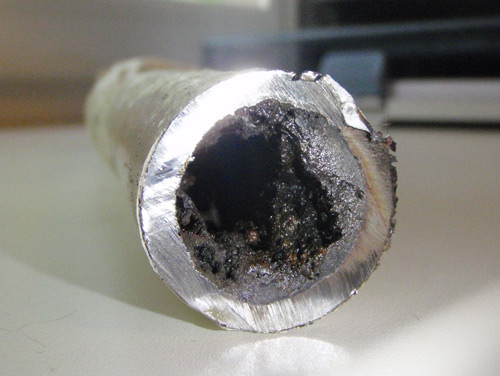
In a word, if your battery does not heat well, localize the problem, find the cause of the breakdown and proceed to fix it.
Ways to eliminate the “cold radiator” problem
The presence of an air lock in the battery forces you to act as follows:
- Disables first circulation pump . After all, excess coolant pressure in the system can prevent the elimination of the air pocket in the battery. If the radiator is connected to central heating this recommendation can be ignored.
- Next, the Mayevsky tap opens , mounted in the radiator from the side of the free upper fitting. The tap is opened by simply turning the valve clockwise. And they close, accordingly, by turning the valve in the opposite direction. If there is no tap, the plug is rolled up at the same end.
- After this you will hear a characteristic hissing , upon completion of which water will flow out of the tap or slightly open plug. Therefore, before manipulating the tap or plug, you need to place some container under the edge of the battery.
- In the final you close the tap and turn on the circulation pump.
After some time, you should check the results of the work done - touch the battery and evaluate its temperature. If the battery gets warm, you did everything right. True, it will not warm up quickly, so be patient.
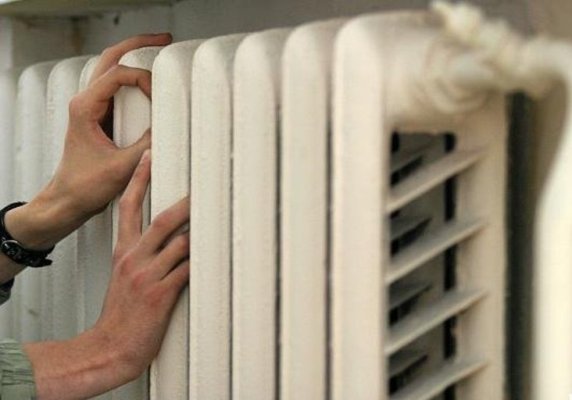
Touch the radiator
The insufficient volume of coolant is restored by supplying water to the open expansion tank or by filling the hydraulic accumulator built into closed system.
Moreover, pumping an additional portion of water into a closed system is carried out as follows:
The circulation pump turns off
- Air is bleed from the hydraulic accumulator. To do this, press the nipple pin.
- At the highest point of the wiring, the air bleed valve opens.
- A shut-off valve opens on the connecting wiring and water supply line. Water will flow into the system directly from the water supply and will fill the wiring until it flows out of the open air bleed valve.
- After this, it is necessary to close the air bleed valve and the shut-off unit on the liquid supply line to the system from the water supply.
- Finally, the air volume in the accumulator is restored by monitoring the pressure level in the system with a pressure gauge.
If after these manipulations your batteries become warmer, you have eliminated the detected defect. However, after the arrival of a fresh portion of coolant, the likelihood of air pockets appearing in the body of the radiator itself increases. We discussed how to fix this problem above in the text.
Removing blockages in pipes on your own is only possible if you have a plumbing qualification or experience as a plumber. Therefore, it is better to leave the solution to this problem on the shoulders of professionals.
After all, to eliminate this problem, you need to dismantle the dangerous area and clean the pipe. After which all dismantled elements will be put back in their original place or replaced with new fittings.
![]()
Examination by a specialist
The same should be done if, in your opinion, the battery is connected to the wiring incorrectly. Whether you connected it yourself or entrusted such work to some unfortunate craftsmen - it doesn’t matter anymore - just show your wiring to another specialist in heating systems. Perhaps you or the technicians who assembled your system made a mistake. And only another specialist will notice this error.
Radiator malfunction after repair
If your heating radiator does not heat after repair, then the most likely cause of such a defect is either air in the system or an error when connecting the battery to the wiring.
After all, replacement or repair of radiators takes place when the coolant is partially pumped out of the system. Well, after supplying water to the wiring, the risk of air pockets in the battery increases almost by an order of magnitude.
Therefore, when adding water to the system after repair, do not forget to open the plugs or Mayevsky taps, monitoring the filling of the batteries by the stream of water flowing from the battery through the shut-off and control valves. If the moment is missed, then air jams will have to be dealt with using the methods described above.
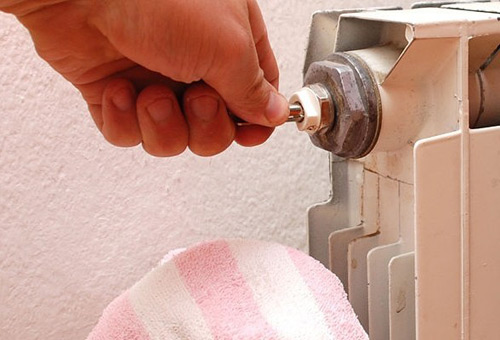
Bleeding air from the system
Errors in connecting the radiator to the system are possible only in case of unprofessional installation. Inexperienced " House master"may overestimate his skills and abilities. To eliminate the consequences of such errors, you will have to call an experienced professional to your home who can conduct a wiring audit and eliminate the mistake of the previous “master.”
Often residents multi-storey buildings They encounter a problem when the radiator stops heating. To begin repairs, you first need to find the source of the problem. There may be several reasons, as a result, and methods for eliminating it may also differ.
Air lock - what to do?
The formation of an air lock in the battery is a common problem. Typically, air can accumulate at the top of the radiator. To eliminate this problem in modern heating devices a special tap is used, which has a two-millimeter hole for releasing air. It is called the “Maevsky tap”. After turning the tap, a slight hissing sound will be heard. When water is supplied, the tap must be turned off.
Note! In some cases, it is recommended to keep the tap open for some time, since air can often come out with the water.
However, prudence must be exercised here. If you drain water for a long time, the volume of coolant in the system can significantly decrease. Therefore, it will be effective to bleed the air again after a certain period of time.

If the apartment is still used cast iron batteries, then they do not have a Mayevsky tap. What to do in this case? To do this, you must use a pipe connection. The work process is complex and unpleasant, since with this option a large volume of coolant will be spilled. You must handle the threads carefully when performing this task. The thread can be either right-handed or left-handed. When unscrewing the coupling, do not apply much force, as the thread may be stripped. crank threaded coupling must be done carefully and smoothly. As soon as the hiss of air is heard, unscrewing the coupling is enough. As soon as water flows, the coupling must be returned to the reverse position.
Note! When tightening the coupling, it is recommended to use a sealant, for example, fum tape or tow. A few turns will be enough and the connection will not leak after a while.
What to do if there is no heat in the last radiator? Usually from the last battery the pipe goes to the expansion tank. Then, most likely, a blockage has formed in this section of the pipe. The situation can be corrected by the laborious and complex work of cleaning the pipe. But first of all, you need to make sure this is a problem or not. Therefore, first, the patency of the pipe is checked.
Connection error
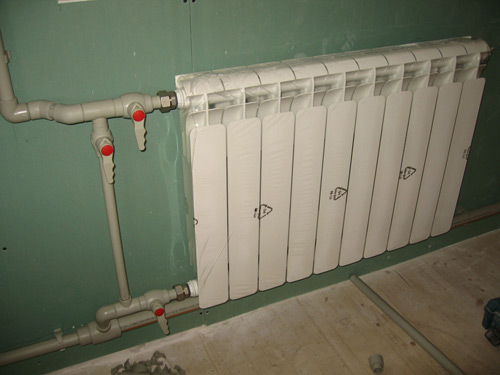
The reason that the radiator does not heat may be due to errors in the installation of heating equipment.
- Incorrect use of bypass. The bypass is a special adapter that connects the outlet and supply of coolant to the battery pipes. Its installation is carried out directly in front of the radiator. This is due to the fact that, if necessary, the battery can be easily and quickly removed. The reason that the battery does not heat up may be that the bypass is in the open position, resulting in incorrect circulation.
- Wrong choice of heating system: two- or one-pipe. Lack of heat may be due to incorrect calculation of the number of batteries, pipe diameter and type of heating system. As a result, there will simply not be enough coolant energy.
There are no hopeless situations, so the problems described above can be solved with the involvement of a qualified specialist.
Doesn't heat up after repair
The battery may not heat up immediately after repair. How to determine what the problem is? Here, what exactly has changed in the apartment will play a big role. For example, pipes can be covered with plasterboard. When installing the profile, the pipe may touch it. As a result, this item will absorb heat that should be directed to the radiator. That is, heat will spread in the space between the rough wall and the drywall. What to do in this situation? To do this, you should check at what level the battery was heated before repair. If after repair it heats less well, then the cause should be quickly eliminated.
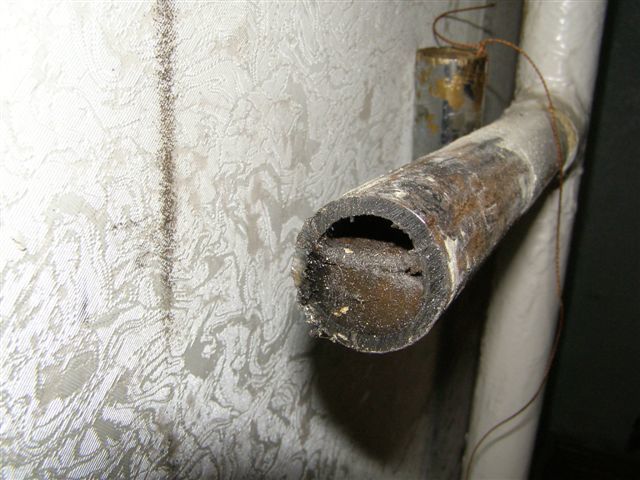
The reason for the insufficient heat of the battery may lie in a blockage. The blockage is explained by the fact that after a long period of heating operation, the internal diameter of the pipes could be significantly reduced due to the appearance of rust. As a result, it may turn out that there is no room in the pipe for the circulation of coolant flow. In such cases, it will be necessary to carry out work to clean the battery or completely replace it. To clean or replace the radiator, shut off the coolant supply to the bypass. In this case, the entire system will continue to work. If you can get by with just cleaning, you can use the tips below:
- It is important to remember safety, as the coolant can be very hot.
- Cleaning should only be carried out under high pressure water.
- Before reinstalling the radiator, you should check the pipe connections; there may also be a blockage at the joint that can be cleaned.
- It is recommended to clean the radiators all at once.
Possible other reasons

Every single case when heating equipment does not heat is unique. Sometimes the reason can be very simple. If used central heating, then the heating may have been temporarily turned off. In this case, it is useless to take any action. You just need to wait until the boiler room fixes the problem.
If the last radiator does not heat, then most likely the heat does not reach it. Accordingly, it is necessary to reconsider the operating efficiency and circulation capacity of the coolant in the heating system. In this case, it is necessary to check the pump, as it may not be able to cope with the load.
An expansion tank can help solve other problems. How? If the problem is airing, then the coolant can be driven through the entire system with a pump. To do this, when installing the entire heating system, you can make a special valve on which a tap fitting is installed. A hose is put on it and water is supplied. After this, you need to wait until the water squeezes out the air through the expansion tank.
Note! This method is very risky. Water may fill the expansion tank. Therefore, there is no way to do this without a partner. One will start the water, and the second will check the water level in the tank.
After carrying out all these actions, the system can heat properly again.
The master's work is afraid!
So, as you can see, the heating system can be fraught with a large number of tricks and tricks. It’s not always possible to immediately figure out what to do. If you have never had to figure out the problem of why the radiator does not heat, then, most likely, it will be useful to watch a useful video that will tell you about one method for troubleshooting the problem. In this case, you will be able to solve the problem yourself and without the involvement of specialists.
Maybe the neighbors are to blame?
It may sound trivial, but first make sure that you have hot water in your home, whether the tap is open for it to flow, or the riser is closed due to plumbing work in the basement. Don’t be too lazy to run through your neighbors on the upper floors. In the event of unprofessional repairs, some of them will have a comfortable radiator temperature, but all the residents below the riser will not receive heat and will be cold.
You have every right to come in like a neighbor with the question “the batteries are not heating: what to do”, and at the same time check their heating temperature. If you find a battery that is warmer than yours, then the problem that has arisen may be limited to just incorrect installation neighbor's valves. Your further actions will depend on the situation; perhaps the shut-off valves, which deprived other neighbors of comfort, will be removed without a scandal. Or call your housing and communal services structure and, with the help of the administration, restore civil justice.
Briefly about the heat supply of an apartment building
If you have the courage to figure out on your own why the batteries do not heat well, it would be a good idea to familiarize yourself with the basic concepts associated with heating a residential apartment building.
Most high-rise buildings use a single-pipe system equipped with U-shaped risers. Let us show a conditional diagram of the heat supply of three floors.
Hot water (red in the diagram) rises through one riser and passes, for example, through the bedrooms, to the top floor, where, in a loop, it goes down through other rooms ( Blue colour). This scheme has been designed since Soviet times for the use of cast iron radiators. Hot water enters the lower radiator manifold and, after passing through all sections, leaves the battery through the upper manifold.
A special role was given to jumpers (bypasses). They maintained a common forced circulation along the entire pipeline of the U-shaped riser (in the diagram - for the six radiators shown), acting as a safety net in cases where the radiators become clogged with liquid technical dirt that accumulates during many years of operation. When passing through the riser, some part of the total displacement of hot water supplied from below turned to the radiator on one floor, and the rest passed by unhindered, delivering heat to the apartments adjacent to the riser.
The aluminum heating radiators that have appeared are designed for two-pipe systems with hot water supplied through the upper collector and its output from the lower collector. They have a completely different design of the internal cavity, and accordingly, different hydraulics. When they began to indiscriminately change obsolete cast iron radiators to modern aluminum ones, but maintaining single-pipe scheme, then inside the batteries the heat flow from hot water began to weaken due to the divergent directions of convection heat flows from the cooling water and the hot water pumped by an external pump.
Concerned that the heating radiator was not heating up, residents began to resort to various technical tricks, not caring at all about their freezing law-abiding neighbors. This inconsistency between the types of structures and the decrease in the speed of water passing through the radiator led to dirt deposits in the sections. Every year more and more sludge is deposited, and now it no longer warms last battery completely clogged with sludge. This epidemic then covers the entire radiator.
So, everything is fine with the neighbors, the riser in the apartment is hotter than the cooled battery. This means the problem is local, it's all in the radiator. An excursion into the basics of heat supply convincingly showed that the main reasons why the last battery does not heat and makes the freezing owner so sad will probably be:
- Clogged radiator sections. Due to scale, rust, mineral salts and other impurities settling on the walls of the radiator, the flow area for hot water in the battery is sharply narrowed, the radiator becomes almost impassable for the coolant. Multilayer contamination of the radiator walls has a low heat transfer coefficient, which negatively affects the transfer of heat from the battery to the air in the apartment.
- Single pipe heating system. As discussed above, the batteries of this system are doomed to a kind of thermal injustice: distant batteries do not heat up.
- Incorrect connection. Only part of the battery heats up and, for example, the bottom of the battery does not heat up.
- An air lock formed from the accumulation of air in the upper part of the radiator. It practically paralyzes water circulation and leads to corrosion of steel surfaces.
- Low pressure in the system. Accordingly, less heat enters the living space.
What can you do for a cold battery?
Clear a blockage in the radiator
In this case, washing with water under pressure will help. In order to easily remove the radiator during the heating season, a bypass must be installed. But it is better to resort to the services of a plumber, who will clean the radiator tank of sludge with a special chemical composition.
Convert a one-pipe system
Change in the most single pipe system nothing is possible. All that remains is to mount two-pipe system water heating.
In case of incorrect connection, it is necessary to redo the circuit
It is important! Of the three types of battery connections - bottom, side and diagonal - the most the best option is a diagonal pattern.
In case of connection error a clear sign serves as uneven heating of sections and their parts, for example, the lower part of the battery does not heat. The sections closest to the connection point will be warm, the rest will be almost cold. With a side connection for a multi-section radiator, the water will not “want” to flow around the entire battery at all, but will pass along the shortest path from the lower pipe to the upper one. Only an experienced plumber can help sort out this confusion.
To correct all connection errors, an injection tube is recommended, which is essentially a flow extension. It is inserted into the battery feed-through nut, effectively simulating diagonal pattern and ensures that the coolant passes more than 70% of the entire working length of the flow section. By increasing the length of the hot water supply, uneven heating of the battery is corrected and the heat transfer of the heating system is improved.
In the absence of normal heat flow through the riser, it is necessary to “pull out” the mechanics from the housing and communal services structure servicing the house. But problems with low coolant temperatures should exist in all apartments along the riser, above and below yours.
One of the reasons why the battery does not heat up is airlock in the radiator. To eliminate it, it is recommended to screw in a special Mayevsky valve instead of the side plug of the radiator. If there is a need to bleed air from a cooled battery, you can do this yourself. To do this, insert a screwdriver into the thread on the tap and slowly turn it counterclockwise. As soon as you hear the sound of air escaping with a hiss, the working rotation of the screwdriver must be stopped.
It is important! When preparing to open the tap, it is necessary to clear the area near the battery, because a stream may escape with air. dirty water, capable of staining everything around. Place a basin below the radiator.
If you did everything according to the instructions, but the battery does not heat up, it means that the radiator is seriously clogged. You can no longer do without a plumber.
Have you suddenly started to notice that the battery does not heat well, does not warm the room well, and does not give off enough heat? There is only one reason for this problem: hot water does not flow completely or partially into the heating radiator. Of course, a qualified technician will be able to quickly solve the problem, but is it worth ringing the bells right away? Maybe first try to figure it out yourself?
The battery does not heat well
This may seem trivial, but first you should check whether there is hot water in the apartment, and whether the tap is locked to allow it to flow. Perhaps the riser is temporarily blocked due to an emergency or repair situation at one of the neighbors.
There are also frequent situations when the radiator in the apartment does not heat due to the fact that the residents on the top floor incorrectly installed the valve on the radiator. Thus, the temperature in their apartment will be very comfortable, but people living below will be left without heat.
Unfortunately, unprofessionally produced plumbing work often cause cold radiators in neighboring apartments. Keep in mind that you have every civil right to contact the residents on the floor above with a simple question: how are things going with the heat in their home? If they make a mistake, housing and communal services will certainly restore justice.
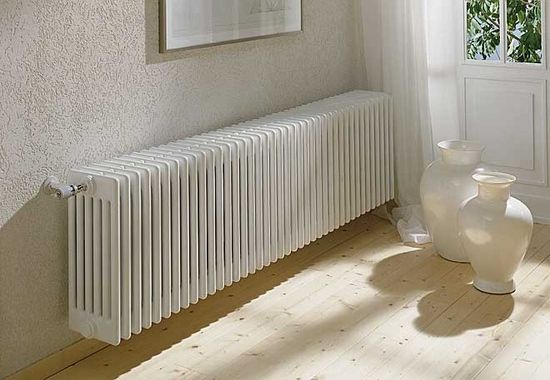
Why the battery does not heat up: common reasons
If everything is fine with your neighbors, the riser is hot, but your house is still cold, then the problem is directly related to the radiator:
- The battery section is clogged. Scale, salts, rust and other impurities tend to be deposited on the inner walls of the sections. The passages for the coolant are catastrophically narrowed, and in such conditions normal circulation is impossible
- Single pipe system. Such a system has a fundamental drawback: long-distance batteries will be cold while they practically do not heat up
- Airlock. The air accumulated in the upper compartment of the radiator forms a kind of plug, almost completely paralyzing the circulation of the coolant. The rapid appearance of corrosion in “aired” areas is also characteristic.
- Incorrect connection. Often batteries do not heat up precisely because of inept handling when connecting. If mistakes are made, only part of the radiator will be active (for example, the bottom)
- Low blood pressure. If in central system heating pressure is very low, which means the water circulation in the battery is weak. That is, much less heat enters the room than it should
Where to turn if the batteries do not heat up
If you were unable to solve the problem yourself, you should immediately contact the management company with a complaint about poor heating. Alternatively, you can call the dispatch service that services the house. But in this case, it is better to write down the date of the call and the personal details of the operator. As a rule, a supervisory technician (or company engineer) should appear on the same day to determine the problem. After taking control temperature measurements, the technician will draw up a report in two copies (the second for the owners). If the complaints are valid, the problem will be resolved in the near future.
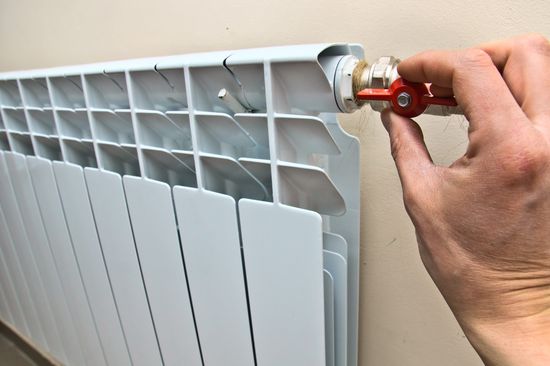
If the cause of the cold in the house is indeed a faulty radiator, you should contact the housing and communal services department. A full-time plumber must come to you, determine the cause of the breakdown and fix it. In case neither one nor the other service provided adequate assistance, there is a hotline. The operator on duty will accept your complaint, explain the situation and tell you where to go next.
